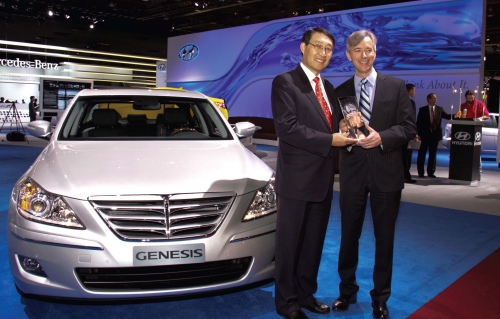
What are the cars of the future These futuristic autos are characterized by the use of new engine and fuel cell technology to emit less and ultimately no carbon dioxide. Cars gushing carbon dioxide from their mufflers will not even be able to meet customers in showrooms in the near future as the world moves strongly towards regulations for carbon dioxide emissions.
To produce environmentally- and energy- friendly cars, Hyundai is working closely in tandem with its sister auto maker KIA. The focus was put on two projects. One is the production of hybrid electric vehicles (HEV) and the other is the manufacturing of hydrogen cell batteries. The formation of a new brand and organization is under way as a whole so that the entire Hyundai-KIA Automotive Group can share the purpose of the cars of the future.

As is well known, the hybrid vehicle pairs the traditional internal combustion engine with a newly designed electric motor. Hyundai-KIA's HEV is very close to commercialization. It is energy-friendly and relatively easy to manufacture using existing technology. Hyundai-KIA predicts that almost all auto makers will have at least one model for assembly by 2010 and 14 million HEVs, 18% of the world market, are expected to be handed over to customers across the world by 2020. Toyota, a leading developer in HEVs, announced that it expects to sell one million HEVs in that time.
Hyundai-KIA jumped into the HEV market by supplying 50 HEVs to the government in October 2004. Since then, they have accumulated experience by increasing the supply of HEVs annually from 350 in 2005 to 730 in 2006 and 1682 in 2007. As a result of the endeavor, Hyundai-KIA will assemble the cuttingedge HEV Avante LPI Hybrid, one of the most advanced technologies in the world, in September this year. The effort will be highlighted by the following commercialization of the Porte LPI Hybrid. Avante LPI Hybrid car is adopting a soft hybrid technology, which means the motor helps the engine start and increases the speed to improve gas efficiency. This means that a user can get 21.3km out of one liter of gas, 53% higher than existing car models. The amount of carbon dioxide emissions decrease dramatically from 167g/km to 102g/km. Hyundai and KIA have proven that the new HEV is not only eco-friendly but also energy efficient. The two are also very proud of having developed all of the motor, controller and battery parts, all of which are essential in terms of competitiveness in the market, because they can be parts-independent from other companies.
It is also historic that the Avante LPI Hybrid will use a Lithium polymer cell for the first time not only to reduce the weight and the space that the existing nickel cell takes, but also to increase the function. This is the outcome of a sevenyear cooperation with LG Chem.
After its launch in the domestic market, Hyundai-KIA will export the Sonata Hybrid to the US market in 2010. The Sonata HEV will be a full hybrid system, which means that the electric motor will run the car at a low speed without any help from the gas engine. The car will get 20km per liter, an increase of 60~70% from existing models.
The Hydrogen Fuel Cell Electric Vehicle is one of the primary targets for Hyundai-KIA. It uses the electricity created by the reaction of hydrogen and oxygen to turn the motor. Thus it produces no air-polluting gases when starting the motor. Hyundai-KIA has been working on its development since 1999. It assembled a fuel cell for the Sportage in 2000 and the Tucson in 2004. In 2004, the US Department of Energy selected Hyundai to take on a test drive in 32 cities across the US.
For domestic tests sponsored by the Ministry of Knowledge Economy, Hyundai-KIA's fuel cell vehicles, including buses, have been running on the roads since 2006. It will test 20 advanced fuel cell vehicles. Hyundai was one of five makers to successfully finish a hydrogen fuel cell vehicle race from Portland, Maine to Los Angeles, California. Hyundai supplied fuel cell buses for the 2006 FIFA World Cup in Germany and received an “A” in the World's Eco- Friendly Vehicle Race sponsored by Michelin and Bibendum. Hyundai-KIA plans to assemble fuel cell vehicles for full sale in 2012.


